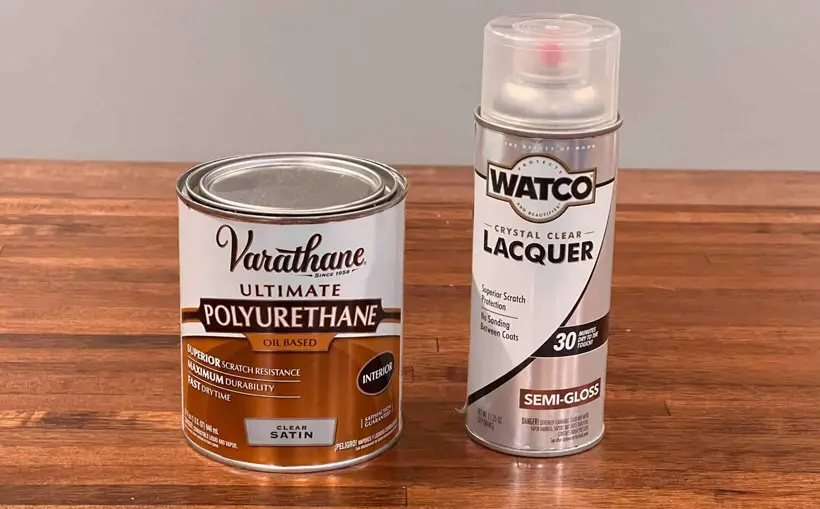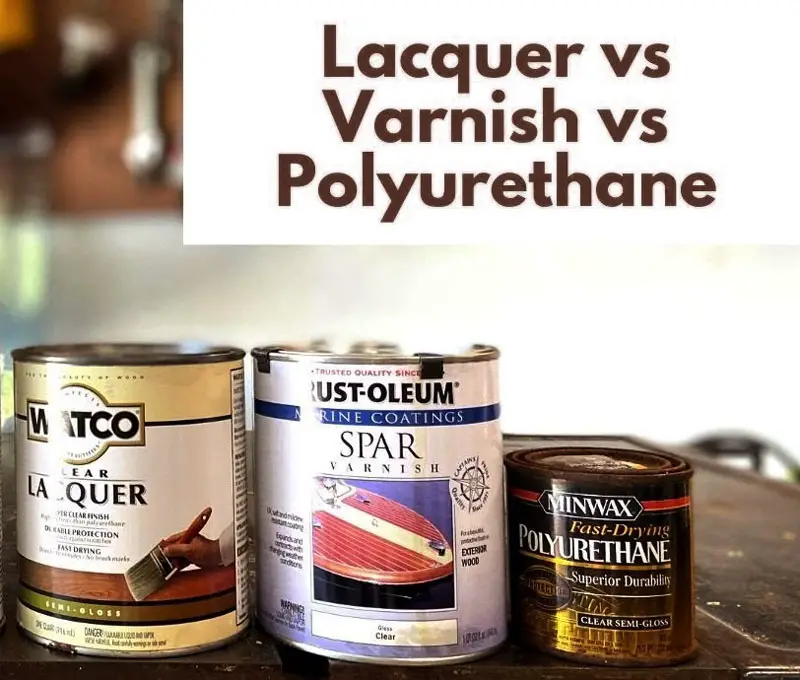Lacquer Vs. Varnish Vs. Polyurethane: An In-depth Comparison
Though the lacquer, varnish, and polyurethane terms look similar, they have slight differences in their durability, chemical resistance, and toxicity. If you use them interchangeably, you may find it difficult to apply and maintain the finish. Also, you won’t get the expected shine after applying the finish.
Now, let’s see the lacquer vs. varnish vs polyurethane comparison. The first one is easiest to apply and repair, dries fastest, gives the highest gloss, and is the cheapest among all these finishes. Then, the second one is less durable, toxic, moderately glossy, pricier, and more sensitive to chemicals than the last one.
In this article, we will provide you with the key differences between these three finishes. We will also show a detailed comparison between them which will help you to choose the best fit. Thus, keep reading.
Table: Differences Among Lacquer, Varnish, And Polyurethane

Let’s see several key differences between these three finish types:
| Criteria | Lacquer | Varnish | Polyurethane |
|---|---|---|---|
| Durability | 12 years | 3-5 years | 10-20 years |
| Chemical resistivity | Can resist alcohols, acids, and alkalis | Can’t resist chemicals like alcohol | High resistance to chemicals like alcohols and weak acids and bases |
| Toxicity | Toxic and dangerous even after drying | Toxic | Toxic and irritating |
| Sheen | Most glossy and reflective | Moderately glossy | Semi-gloss to satin |
| Drying time | 30-60 minutes | Oil-based: 6-24 hrsWater-based: 30-60 mins | Oil-based: 24 hrsWater-based: 6 hrs |
| Ease of application | Easiest application | Relatively tricky | Relatively easier |
| Price | $0.63-$2.25 per ounce | $1.09-$2.67 per ounce | $0.87-$1.87 per ounce |
| Repair | Spraying wet coat | Steel wool, then paste wax | Sanding and recoating |
| Applications | Decorative objects | Outdoor surfaces | Indoor furniture, floors |
Lacquer Vs. Varnish Vs. Polyurethane: An In-Depth Comparison
As you already know the key differences between them, it will be easier for you to compare them now. We will now discuss their distinguishing characteristics in detail to ease the comparison task.

1. Durability
Among three of these finishes, polyurethane has the highest durability. It can last up to almost 10-20 years in indoor applications. The lacquer finish can last up to 12 years without any fading issues.
But the varnish has lower durability of around 3-5 years. You will find them primarily in outdoor uses; thus, they encounter harsh weather and humidity changes. Applying the other two finishes to outdoor furniture may not last up to their expected lifespan.
Generally, the varnish has UV blocker additives in its formula. That’s why it may not fade over time under direct sunlight. Yet, as the other two don’t have those UV blockers, they will fade if you apply them on outdoor surfaces.
2. Chemical Resistivity
In the case of chemical resistivity, polyurethane, and lacquer are better choices. Generally, the varnish finish will get damaged if you try to clean it with chemicals like alcohol, acids, or alkalis.
But polyurethane can resist alcohol and dilute acid and bases. It can resist weak acids like citric acid, phosphoric acid, etc. Also, the lacquer can withstand diluted acids like hydrochloride and nitric acids.
3. Toxicity
Three of these finishes will emit toxic fumes during application. Typically, the Polyurethane finish will emit more hazardous volatile organic compounds (VOCs) like n-decane, isopropylbenzene, etc., when you apply it on the surfaces.
Generally, these VOCs will irritate your skin, can cause respiratory issues, and are also carcinogenic. The VOCs generated from the varnish are less in quantity and toxicity than the polyurethanes. But both of the finishes are safe once they become dry.
Similarly, the lacquer finish will emit a high amount of VOCs during application. Thus, you must wear a respirator while doing this job. Even after drying, this finish may emit a small amount of VOCs inside the house.
Therefore, you need to reduce the negative impact by keeping the temperature at 40°C, 40% humidity, and unit air exchange rate to loading factor.
4. Sheen
Among three of these, the lacquer gives the most glossy and reflective finish. Polyurethane finish can also provide a high sheen, although it may not be as glossy as lacquer. Still, it will enhance the wood’s appearance by producing a shiny, and reflective surface.
On the other hand, the varnish finish tends to have a slightly lower sheen than the other two. It will produce a moderate level of shine which won’t be as reflective as the other two finishes.
5. Drying Time
Oil-based varnishes can take anywhere from 6 to 24 hours to dry. But the water-based ones may dry within 30-60 minutes. Yet, oil-based polyurethane will require at least 24 hours to dry.
There are also fast-drying versions of oil-based polyurethanes, which will dry within 4-6 hours. Besides, the water-based version will take less time, 6 hours. Moreover, the lacquer finish will take the least time to dry, which is 30-60 minutes.
6. Ease Of Application
You can apply the varnish using a paintbrush. Due to their thickness, it’s tough to use them in a spray bottle. For that, you may need to dilute the varnish, consequently which will require more coating layers.
However, you can use a bristle brush or roller to apply polyurethane on the surfaces. As they dry slightly slower, you will have enough time to remove brush strokes while applying.
As the lacquer is thinner than other finishes, you can apply it easily with a spray bottle. For this, you will require a high-volume low-pressure spray bottle of the lacquer.
7. Price
Generally, the lacquer will cost less per ounce than the polyurethane and varnish. Buying lacquer requires around $0.63-$2.25 per ounce. But for buying polyurethane or varnish, you must spend up to $0.87-$1.87 and $1.09-$2.67 per ounce, respectively.
8. Repair
The repairing method is easier for lacquer as you just need to spray another thin coat of lacquer over the surface. In case of repairing varnish, you can use steel wool grade 0000 and then paste wax on the damaged area.
But the repairing process is slightly troublesome in the case of the polyurethane finish. First, you need to sand the surface and then wipe the dust from the surface. After that, you can apply a new thin coat of polyurethane to repair the blemishes.
9. Applications
Among these three finish types, varnish is popular for outdoor applications, and polyurethane is for indoor applications. But as lacquer gives the most glossy finish, you will see its applications on decorative objects, cabinets, furniture, and musical instruments.
Then, you can apply the varnish commonly on the door’s exterior surface, trim, outdoor furniture, fences, etc. Besides, in indoor applications like floors, furniture, countertop, kitchen and bathroom appliances, etc, you can use polyurethane finish.
You can check out this YouTube video to understand the differences between them better:
Which One To Choose Among Lacquer, Varnish, And Polyurethane?
All these three finishes are durable and best at their place. Thus, which one is better will depend on your requirements and preferences. Here are a few things that you can consider while selecting the suitable one:
- Application sector: If you are looking for a finish for a surface that encounters excessive traffic, pick polyurethane. This finish can dry hard and resist wear due to excessive traffic.
But if the surface faces direct sunlight, heavy moisture, humidity, and heat, the varnish will be the best choice. If the indoor surface requires a shiny finish, we recommend choosing lacquer.
- Cleaning: If the surface requires frequent cleaning with alcohol, you shouldn’t choose varnish. It will damage the color and coating of the finish. In this type of case, polyurethane and lacquer is a wise choice.
- Color of surface: Varnish naturally has a yellowish tint and will give a yellowish appearance. Also, the varnish may get amber over time. That’s why it’s more suitable for darker color surfaces.

But the polyurethane and lacquer will give a clear appearance to the surface. Polyurethane is better as it will remain the same till the end. Besides, the lacquer can fade over time, which will also be unnoticeable if the surface color is light.
If you’re in the process of comparing lacquer, varnish, and polyurethane finishes, our article on can you put polyurethane over acrylic paint matters might provide insights that could help you make informed choices for your finishing needs. Moreover, if you’re considering using polyurethane over surfaces painted with chalk paint, our guide on can you use polyurethane over chalk paint might offer valuable information. We understand the importance of selecting the right finish and addressing specific painting scenarios, and our comprehensive resources are designed to help you navigate and make the best decisions for your woodworking projects.FAQs
In this FAQs section, we will answer a few questions about lacquer, varnish, and polyurethane.
Q: Can I Apply These Finishes (lacquer, varnish and polyurethane) Over Other Existing Finish?
It will depend on the compatibility of the finish with the existing finish. We recommend completely removing the existing finish. Yet, apply the finish by sanding the previous finish properly to ensure proper adhesion of the new finish.
Q: Is Lacquer, Varnish, Or Polyurethane Suitable For Applying To Metal Surfaces?
Yes. You can apply these finishes over the metal surface. In the case of varnish and polyurethane, you need to apply a primer over the surface first, then you can proceed with applying the finish. Yet, you can apply lacquer on the surface with or without any primer.
Q: Are Lacquer, Varnish, And Polyurethane Flammable?
Generally, they are flammable in their liquid state; thus, you need to keep them away from heat sources. Water-based polyurethane and varnish aren’t flammable whereas oil-based ones are. Besides, the lacquer finish also has high flammability and explosivity.
Conclusion
Polyurethane is the most durable option for varnish and lacquer. But if you apply it on any outdoor surface, the finish will have cracks, damage, or color fading issues. In this case, the varnish will serve the best. We already mentioned this in our lacquer vs. varnish vs. polyurethane comparison.
All of them produce toxic VOC fumes during application. That’s why you must wear respiratory masks before applying these finishes. Generally, polyurethane is more toxic than the varnish. Yet, unlike other finishes, the lacquer will still emit some VOCs even after drying.





